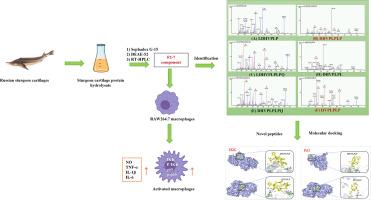鲟鱼软骨中的免疫调节肽:分离、鉴定、分子对接以及对 RAW264.7 细胞的影响
IF 6.5
1区 农林科学
Q1 CHEMISTRY, APPLIED
引用次数: 0
摘要
鲟鱼(Acipenseridae)是一种以鱼子酱闻名的古老鱼类,其副产品(如富含蛋白质的软骨)未得到充分利用,而软骨是优质生物活性肽的来源。这项研究调查了鲟鱼软骨水解物中的免疫调节肽机制。研究发现,鲟鱼软骨水解物 F2-7 及其关键肽(DHVPLPLP 和 HVPLPLP)能显著促进 RAW267.4 细胞增殖、NO 释放和吞噬作用(P < 0.001)。此外,Western 印迹证实 F2-7 可通过增加 NF-κB 信号通路中 P-IKKα/β、IΚΚ、p65 和 P-p65 蛋白的表达来增强免疫反应(P < 0.01)。分子对接进一步证明,DHVPLPLP 和 HVPLPLP 通过氢键与 NF-κB 通路蛋白结合,估计结合能较低(-2.75 和 -1.64; -6.04 和 -4.75 kcal/mol),从而确定了它们在 F2-7 中作为关键免疫肽的作用。因此,DHVPLPLP 和 HVPLPLP 有可能被开发为提高免疫力的膳食补充剂。它们增强免疫功能的能力为新型免疫补充剂提供了理论基础。本文章由计算机程序翻译,如有差异,请以英文原文为准。

Immunomodulatory peptides from sturgeon cartilage: Isolation, identification, molecular docking and effects on RAW264.7 cells
Sturgeons (Acipenseridae), ancient fish known for their caviar, produce underutilized by-products like protein-rich cartilage, which is a source of high-quality bioactive peptides. This study investigates immunomodulatory peptides from sturgeon cartilage hydrolysates mechanisms. The study found that sturgeon cartilage hydrolysate F2–7 and its key peptides(DHVPLPLP and HVPLPLP)significantly promoted RAW267.4 cell proliferation, NO release, and phagocytosis (P < 0.001).Additionally, western blotting confirmed that F2–7 enhances immune response by increasing the expression of P-IKKα/β, IΚΚ, p65, and P-p65 proteins in the NF-κB signalling pathway (P < 0.01). Molecular docking further demonstrated that DHVPLPLP and HVPLPLP bind to NF-κB pathway proteins via hydrogen bonding, with low estimated binding energies (−2.75 and −1.64; −6.04 and −4.75 kcal/mol), thus establishing their role as key immune peptides in F2–7. Therefore, DHVPLPLP and HVPLPLP have the potential to be developed as dietary supplements for immune enhancement. Their ability to enhance immune function provides a theoretical basis for novel immune supplements.
求助全文
通过发布文献求助,成功后即可免费获取论文全文。
去求助
来源期刊

Food Chemistry: X
CHEMISTRY, APPLIED-
CiteScore
4.90
自引率
6.60%
发文量
315
审稿时长
55 days
期刊介绍:
Food Chemistry: X, one of three Open Access companion journals to Food Chemistry, follows the same aims, scope, and peer-review process. It focuses on papers advancing food and biochemistry or analytical methods, prioritizing research novelty. Manuscript evaluation considers novelty, scientific rigor, field advancement, and reader interest. Excluded are studies on food molecular sciences or disease cure/prevention. Topics include food component chemistry, bioactives, processing effects, additives, contaminants, and analytical methods. The journal welcome Analytical Papers addressing food microbiology, sensory aspects, and more, emphasizing new methods with robust validation and applicability to diverse foods or regions.
 求助内容:
求助内容: 应助结果提醒方式:
应助结果提醒方式:


